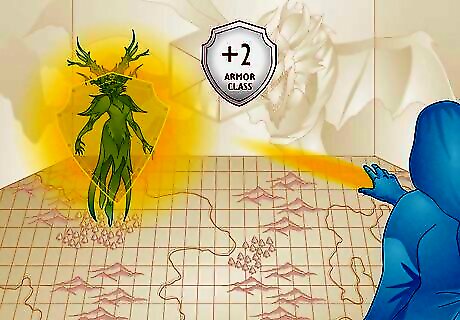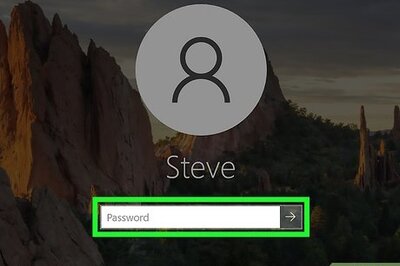
views
- Shield of Faith is a 1st-level abjuration spell that creates a shimmering barrier around the target, giving them a +2 to their armor class for the spell’s duration.
- Shield of Faith is a concentration spell, meaning it can last for up to 10 minutes so long as the caster concentrates on maintaining for the entire period.
- All in all, Shield of Faith is a great spell. It can protect characters, making them harder to hit in battle, and its AC bonus can stack with other magical bonuses too.
What is Shield of Faith in D&D 5e?

Shield of Faith is an abjuration spell that grants a +2 to armor class. As far as spells go in 5e, Armor of Faith is extremely simple—but no less useful! When your character (PC) casts Shield of Faith, they create a shimmering field around their target. As a result, the target’s armor class (AC) magically increases by +2 for the spell’s duration, protecting them from attacks in combat. Range: 60 feet Target: A creature of your choice within range Casting time: 1 bonus action Duration: Concentration, up to 10 minutes Components: Verbal, somatic, and material (A small parchment with a bit of holy text on it)
Shield of Faith Mechanics

Shield of Faith can stack with other spells and magic item bonuses. In D&D 5e, a PC’s armor class determines how difficult it is for enemies to hit them. Thus, the more AC bonuses they have, the higher their AC—and the harder they are to hit. When under the effects of Shield of Faith, you can combine and stack it with other spells and magic items to raise your character’s AC even higher. For example, if your PC had a cloak of protection (which grants a +1 to AC), they could also cast Shield of Faith on themselves (granting a +2 bonus) for a total +3 bonus to their AC. However, stack AC effects by casting Shield of Faith multiple times. No matter how many times you cast it on a creature, their bonus will always be +2.

You must maintain concentration on Shield of Faith after casting it. Shield of Faith is a concentration spell, meaning your PC must focus on it to keep the spell going (and benefit from its bonus) after casting it. The spell can last up to 10 minutes—but losing your concentration by taking damage can cause the spell to end prematurely. To maintain concentration, try: Stay away from the front lines of combat. If you don’t attract enemy attacks or take any damage, you won’t lose concentration. Raise your PC’s armor class. A PC with a high armor class is harder to hit, so give them protective armor and increase their Dexterity score to raise their AC. Improve your PC’s concentration checks. When you take damage, you make concentration checks to see if your PC can maintain the spell. Improve your concentration bonus and pass more checks by: Raising your character’s Constitution score (since Constitution is the stat used in concentration checks). Taking feats like War Caster and Resilient (Constitution), which can both improve your PC’s concentration and Constitution.

Shield of Faith can be cast on your PC or other nearby creatures. The spell’s description states that the spell’s target can be any creature of your choice within range—which means you, or any creature within 60 feet, could get a bonus to their AC. Before casting it, consider which PC or creature needs the bonus most—or which PC is likely to take the most heat in a fight. For example, if you’re about to send a familiar to scout ahead in an enemy’s camp, you might cast Shield of Faith since familiars are animals and don’t have high AC. On the other hand, you might cast Shield of Faith on the party’s tank (a barbarian or fighter, for example), so they can taunt and draw attacks from enemies without getting hit as often. Ultimately, it’s up to you to decide what would help most in a particular situation—so have fun and use your best judgment!
Is Shield of Faith a good spell?

Shield of Faith is useful, especially for low-level PCs. Because it’s a level 1 spell, it doesn’t cost much to cast Shield of Faith in combat (which is good if you’re trying to conserve higher-level spell slots). Beyond that, a +2 AC bonus is always helpful—no matter what your character’s AC is or their level. Therefore, casting Shield of Faith is never a bad idea! The main drawback to Shield of Faith is that it requires concentration, because your PC can’t concentrate on multiple spells simultaneously. If you cast Shield of Faith, you can’t cast any other concentration spell without automatically dropping Shield of Faith.
Which classes can use Shield of Faith?

Clerics and paladins can use Shield of Faith in D&D 5e. Clerics are divine spellcasters who gain spells through faith in their chosen deity, while paladins are holy warriors whose power comes from the sacred oaths that they make. If you decide to play a cleric or paladin PC, you’ll find Shield of Faith on your character’s spell list! However, a couple of different subclasses can also use Shield of Faith: Divine Soul sorcerers and Theurgy wizards. Subclasses are essentially specialized disciplines or combat styles within a class. So, you wouldn’t get Shield of Faith if you played the Wild Magic sorcerer subclass—but you’d get it with Divine Soul because that subclass’s specializations include access to cleric spells.
Advice for DMs

Attack players with Shield of Faith up to break their concentration. This is especially effective if one player casts Shield of Faith on another—because, that way, the PC casting the spell isn’t any more difficult to attack than usual. Regardless, breaking a PC’s concentration means dealing damage until they fail a concentration check, so try focusing enemy fire on them to cancel out Shield of Faith. If you’re a DM (Dungeon Master) running the game, this can also be an important lesson for beginners who aren’t as familiar with strategizing during combat. By concentrating enemies’ attacks on the PC maintaining Shield of Faith, you can show them how important it is for spellcasters to steer clear of the fray while casting a concentration spell.

Describe how the +2 AC bonus looks and feels within the game. What’s more fun than a game that lets you cast spells and wield powerful magic? Describing what that magic looks like, of course! When a player casts Shield of Faith, ask them what kind of visual effect the other characters see. Conversely, as the DM, ask yourself this question and describe Shield of Faith’s visuals to your players. For example, one PC’s Shield of Faith spell might look like a gigantic, sparkling bubble, while another’s might look like an ethereal shield hovering between themselves and an enemy. Then, figure out what it looks like when Shield of Faith actually stops an enemy from landing a hit on a PC. For example, the spell’s shimmering field might deflect the blow and cause an enemy to lose their balance. It could also be fun to ask yourself what happens when an enemy is too strong and lands a hit despite Shield of Faith. For example, you could say that the spell’s magical field appears to crack or shatter as each foe pushes past it.



















Comments
0 comment